- Reviews
- Best Classic Cars
- Ask HJ
- How Many Survived
- Classic Cars For Sale
- Insurance
- Profile
- Log out
- Log in
- New account
Mercedes-Benz 450SEL 6.9 (1975 – 1981) Review
Mercedes-Benz 450SEL 6.9 (1975 – 1981) At A Glance



The 1972 Mercedes-Benz S-Class was a marvellous machine - a technical tour de force, and one that proved so impressive, it managed to win the European Car of The Year award. Something of a scoop for such a luxurious car. The top model had it all - a 4.5-litre V8 and the option of long-wheelbase, for plutocrats who needed lounging room. So, the arrival of the 450SEL 6.9 in 1974, the immediate aftermath of the first Energy Crisis, was something of a puzzle, even if it was the direct replacement for the much-missed old 280SE 6.3.
But the planning and development for the 6.9 could never have foreseen world events, and by the time the Middle Eastern oil reserves were being rationed out at increasingly high cost, it was heading for launch. The existence of the new 450SEL 6.9 was as much about Mercedes-Benz's pride, as it was to slake the demand for a super-fast, super-cool, super-capable saloon for world leaders. It set out to establish Mercedes-Benz as the builder of the world's best saloon in the light of strong opposition from the new Jaguar XJ12. The 6.9-litre V8 engine was lifted from the 600 limousine did the trick, along with self-levelling oleopneumatic suspension, and all that gave the game away visually was a discrete '6.9' badge on the bootlid. It was predictably expensive, but still sold in surprising numbers. Which means they are relatively affordable for today's enthusiast - but this cannot go on for much longer.
Driving Mercedes-Benz 450SEL 6.9 (1975 – 1981)
The Mercedes-Benz 450SEL 6.9 had a justifiable claim on the title of 'best car in the world' when it was launched in 1974. With huge power and torque and an amazing suspension system, it had everything going for it - and strong overall sales back that up.
But it was launched in the midst of an economic crisis, when spiralling fuel costs made running one an operation for the very richest members of society. Even James Hunt left his languishing on bricks. So can the 6.9 cut the mustard today as one of the world's greatest cars?
Classic road test: Mercedes-Benz 450SEL 6.9
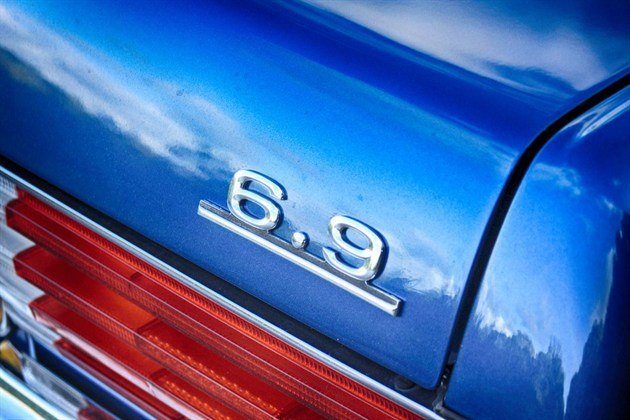
When spending time with the Mercedes-Benz 450SEL 6.9, one is almost constantly aware of the speed in which it consumes petrol. Even more so than the massive power, the incredible ride comfort and immense road presence, any driver that doesn't own their own oil well, will be making fuel consumption equations in their heads as they drive. The thing it, it's easy to blame high 21st century fuel prices with an obsession with parsimony, but consider that only the super-rich would have not been thinking the same way when this car was launched - in the era we now think of as being awash with cheap petrol.
Power was delivered by the legendary M100 V8 that had been developed specifically for the 600, and with a maximum output of 286bhp and 405lb ft of torque, this limousine-sized car was more than capable of sports car-beating performance.
Given decades of almost uninterrupted growth leading up to 1973, it's hardly surprising that many of Europe's top car manufacturers were caught with their pants down thanks to the Energy Crisis. The launch of the Lamborghini Countach and Ferrari BB in 1973 smacked of unlucky timing, but they weren't alone by any means. Across the board, 1974 and '74 changed the face of the market, as buyers clambered to downsize, all of a sudden paying close attention to mpg instead of mph.
Mercedes-Benz also found itself in an interesting position as a result of the Energy Crisis. Although it sold plenty of diesel W114s to cover its bases, the beginning of the 1970s saw a huge expansion of its V8 model plans. The SL roadster moved from six-cylinder Pagoda to eight-pack W107, while the brilliant new 1971 S-Class came in two varieties of V8 - the 3.5- and 4.5-litres. And so good was the W116, that it won the European Car of The Year award for 1974.
That duo of V8s was due to become a trio in late 1973, with Mercedes-Benz planning to launch something truly special, a replacement for the legendary 300SEL 6.3 - once the world's fastest four-door saloon. The 450SEL 6.9 might have looked outwardly rather similar to the vanilla 450, under the bonnet - and on the road - it was rather a different proposition. Power was delivered by the legendary M100 V8 that had been developed specifically for the 600, and with a maximum output of 286bhp and 405lb ft of torque, this limousine-sized car was more than capable of sports car-beating performance.
As appealing as that sounded, it was not the car to be putting on sale in 1974. Mercedes-Benz showed the 450SEL 6.9 at the 1974 Geneva motor show, but ended up delaying putting the impressive new car on sale until May 1975, when there were signs of a tentative recovery in the car's most important markets. Besides, Mercedes-Benz was proud of the 450SEL 6.9, and clearly believed it was the best car in the world - and the only way to prove it was to get it out there, and start selling them. But did its immense spec sheet translate into a magnificent car on the road? Time to find out.
About the Mercedes-Benz 450SEL 6.9
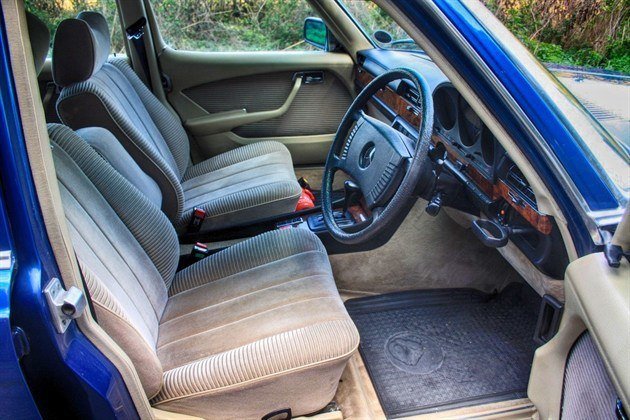
Interior has few of the trappings expected of one of the most expensive cars money could buy - but it's solid, beautifully-made, and works supremely well.
The best place to start is with the engine, as this was the main 'selling point' of the 6.9. It was originally developed in parallel with, and especially for the W100-Series 600 limousine - and as it was a true carte blanche affair, the new engine was given all the toys available to Mercedes-Benz at the time. But for the 6.9, it had been substantially revised.
The updated V8 retained aluminium cylinder heads, nitrided, sodium-filled valves, hardened valve seats, Bosch K-Jetronic fuel injection (a real rarity in 1963), and dry sump lubrication. When the M100 was shohorned into the W116 body, engine capacity increased to 6834cc from 6.3-litres, but it remained as unstressed and refined as it did in the 600, and its immediate predecessor. Transmission was by a three-speed automatic gearbox, and in keeping with the need to cruise for long distances, a 96-litre (21 gallon) fuel tank was fitted.
As for performance, the claims were impressive - 0-60mph in 7.4 seconds and a maximum speed of 140mph. And if you're not that impressed, saying that your hot hatch can keep up, then yes - but it does not weigh 1935kg, some some 200kg more than a stock 450SE. Why the weight difference? It was nearly all in that enormous V8 engine up-front.
The other big talking point was the 450SEL 6.9's Hydropneumatic suspension system, which was the logical next-step evolution of the air set-up in the 600. It was a development of the system first used by Citroen in 1954, but there were one or two important differences, such as the system's HP pump was driven by the engine's timing chain.
As with the Citroen, hydraulic spheres replace the springs and dampers, and they're interconnected. As well as independent front and rear self-levelling, the 450SEL 6.9's set-up also has user adjustable ride height and anti-squat under acceleration and anti-squat for the brakes. The 450SEL 6.9 retained the standard S-Class's rear semi-trailing-arm independent rear suspension set-up, but received an additional Watts linkage to tie it all down effectively.
In West Germany, the 450SEL 6.9 was launched at a price of DM69,930 (around £12,880), and once the worst of 1970s inflation was over in late 1978, this had shaken out to a UK retail price of £24,950. By way of comparison, a Rolls-Royce Silver Shadow II would cost you £26,740, a Jaguar XJ5.3 cost £12,436, and a standard 450SEL came in at £16,380 - so the premium was there for all to see. And yet, the Rolls-Royce was antediluvian in comparison, with its 190bhp V8 struggling to push it to beyond 115mph, while the V12-powered Jaguar - as brilliant as it was - simply lacked the quality in depth. Its closest rivals were yet to appear - the Aston Martin Lagonda and Bentley Mulsanne Turbo.
On the road
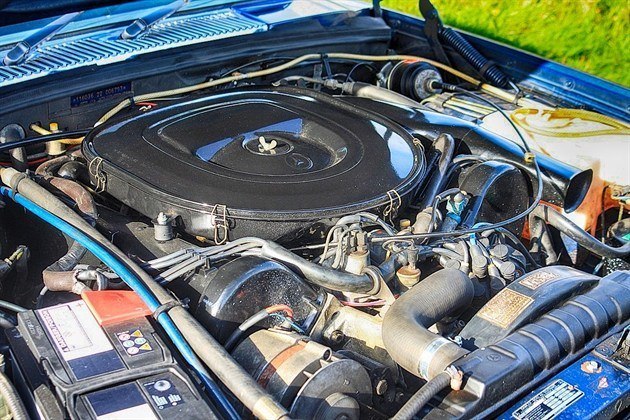
The 6.8-litre W100 power unit, first used in the 600 was a tight-fit in the 450's ample engine bay. But the results on the road speak for themselves.
Firstly, it's worth saying that our test car is cherished to within an inch of its life by Mercedes-Benz UK, and with a little more than 10,000 miles on the clock, and shipped in from Australia, it's not quite typical of what you mght find out there and ready to buy.
There's something deeply cool about the way the 450SEL 6.9 looks. If it weren't for the boot badge (which many owners ticked the delete option on) you'd have no way of knowing what's packing under the bonnet. And we like that - it oozes Q-ship class that very few cars really successfully pull off like this. But then, the W116's understated and balanced looks help no end - it's exquisitely detailed in places, such as the ribbed rear lenses and double-deck bumpers, and there's lashings of chrome on it. But all tastefully applied.
The most obvious comparison is wilth a fully-loaded Boeing 737 - acceleration almost feels languid, but it just keeps buidling, building, building without let-up.
Inside, you'd be hard pushed to believe this was once one of the world's most expensive saloons. The seats are cloth, the instruments and fittings are Daimler-Benz standard, and other than the additional warning lights and suspension controls, it's all pretty normal in here. Compared with a Rolls-Royce, which is clubby and bespoke, it's almost disappointing. But prod, poke and examine, and you'll find there are no holes in the 6.9's quality. The instrument panel is fully featured and an object lesson in clarity, while the seats are supportive, springy and built for full-sized people.
Fire it up, and it catches quickly, settling down to a business-like hum. The throttle travel is long, and initially feels a little dead, but inching forward, smoothly, silently, is part of what this car needs to do. But you want to see what 6.9-litre feels like, so pushing the throttle gently to the floor illicits an instant tidal surge of power, accelerating to the legal limit and beyond hillariously quickly. The most obvious comparison is wilth a fully-loaded Boeing 737 - acceleration almost feels languid, but it just keeps buidling, building, building without let-up. And it's only at A-road speeds and beyond that the V8 makes its presence felt - a deep, melodious and nicely hushed soundtrack that's a perfect reminder of where the money has been spent.
All that performance is held in check by that clever suspension system. It rides the bumps impressively, not just masking the worst of them, but absolutely obliterating them, big Citroen-style. And at speed, it feels stable, unflappable, and long-legged. The steering, positive and well-weighted, is accurate around the centre, but is quick and progressive once you start pusing the 450SEL 6.9 into bends. And this is the part of the this car's make-up we really like - it doesn't heel over excessively in corners, feeling far lighter and more agile than it has every right to.
So it's everything you'd ever want out of a large luxury saloon? Pretty much - although we'd like just a little more luxury inside...
The HJClassics Verdict

The 450SEL 6.9 might look almost identical to more humble S-Class saloons, but it still has huge road presence.
The first thing to say is that if Mercedes-Benz's intention was to build the best saloon car in the world, then it handsomely succeeded. In the class of 1975, there was simply nothing to touch the 450SEL 6.9 on the road - cruising on the motorway, it's near silent, and much of the time, that engine really doesn't make its presence felt at all.And yet, between 50-100mph, it's almost obscenely quick, but addictively effortless, too. Which, back then, if you were paying Rolls-Royce money is the least you should expect.
If you want a classic that cuts it with the moderns in the cut and thrust of the overtaking lane, has absolutely massive road presence, and will not tax you on a long drive, this is the car for you.
But here's the thing - it also stacks up today in a way that no other comparable car would. There's no point labouring the point about the 6.9's thirst - while we had it, we burned through a tank in a little more than 200 miles - and refilling it is mighty expensive too. You know that. We know that, so let's move on.
But if you want a classic that cuts it with the moderns in the cut and thrust of the overtaking lane, has absolutely massive road presence, and will not tax you on a long drive, this is the car for you. Okay, so you will need a large parking space for it, and servicing it is not going to be cheap, and at around £25,000 for a good one - and it won't be as good as this one - you're going to have to really want a Mercedes-Benz, considering how good a Bentley Turbo R or Jaguar XJ12 you can get for less than half the money.
But despite those modern-day misgivings, we love the 450SEL 6.9. It's a survivor that shouldn't have seen the light of day, because in all logic, Mercedes-Benz had all the car it needed with the standard 450SEL. And yet, it made this wonderful, glorious, stormer of a car, when all the legislators really wanted was cities full of superminis. But let's also not forget that the 6.9 is also very cool - think Ronin, think James Hunt, think C'etait Un Rendezvous. And for that reason above all others, the 450SEL 6.9 gets full marks. Sometimes logic doesn't come into just doesn't come into these decisions at all.
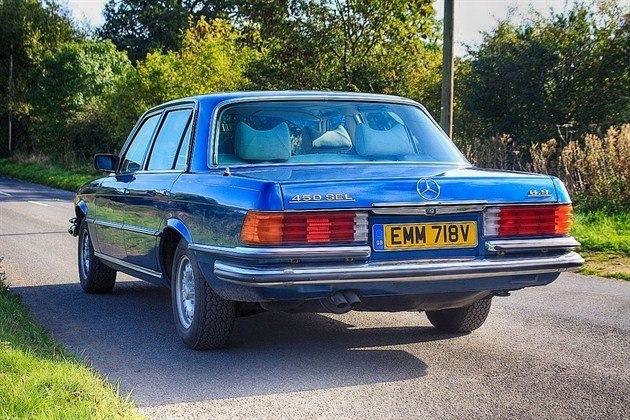
Mercedes-Benz 450SEL 6.9 (1975 – 1981) Buying Guide
Good
- Immense performance
- Acres of interior room
- Massive road presence
- Unimpeachable build quality
Bad
- Huge thirst and running costs
- Parts prices for 6.9-specific items can be eye watering
Watch
- These cars are so expensive to fix - if it's a 6.9-related problem - that they end up laid-up and out of action. So, check for signs that you're not looking at a car that's been out of use and not properly recommissioned.
- Rust isn't a particular problem, thanks to high-quality steel, but it's not unknown for lightly-used non-garaged cars to suffer from corrosion. Always check the leading edges of the sills, inner wings and door bottoms.
- The M100 engine is near-bulletproof, thanks to being so unstressed. Make sure that oil has been changed on a time - and not mileage basis - for lightly used cars.
- Check the big-end and main bearing shells on any low mileage cars.
- but water pumps can cost £3000-plus to fix.
- Fuel injection is reliable.
- Transmission is extremely tough.
- Hydraulics can cause problems - on the 6.9, and its long pipe runs, check closely for leaks. They can occur anywhere.
- Hydraulic pump failure is rare, but costly, so make sure it's quiet and operational.
- Also check the condition of the accumulator - it stores pressure.
- Make sure the suspension system charges as it should - when fired-up, the red light on the dash should go out after no more tha 20 seconds.
- Interiors were often velour and PVC, with leather an optional extra - retrimming is strightforward and not cheap.
- Also make sure the interior wood is all as it should be - there's a lot of it, and it is expensive to refurbish.

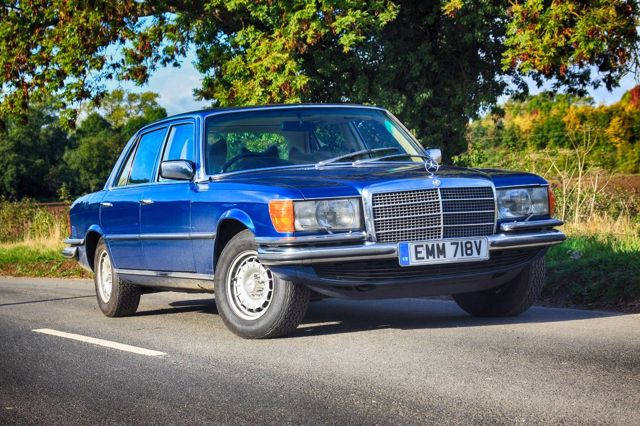
.jpg?width=640&height=426&rmode=crop)
.jpg?width=640&height=426&rmode=crop)
.jpg?width=640&height=426&rmode=crop)
.jpg?width=640&height=426&rmode=crop)
.jpg?width=640&height=426&rmode=crop)
.jpg?width=640&height=426&rmode=crop)
.jpg?width=640&height=426&rmode=crop)
.jpg?width=640&height=426&rmode=crop)
.jpg?width=640&height=426&rmode=crop)
.jpg?width=640&height=426&rmode=crop)
.jpg?width=640&height=426&rmode=crop)
.jpg?width=640&height=426&rmode=crop)